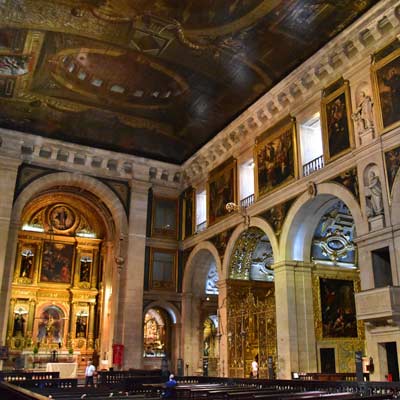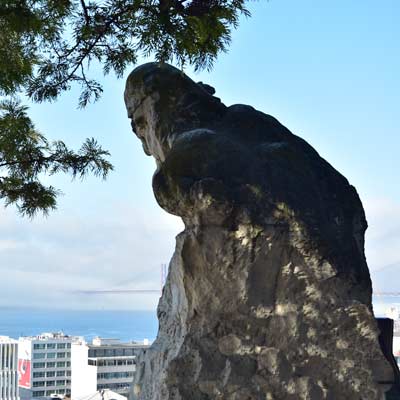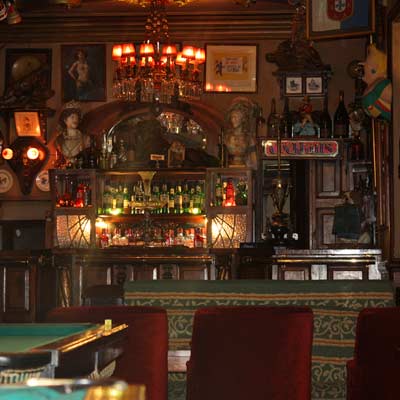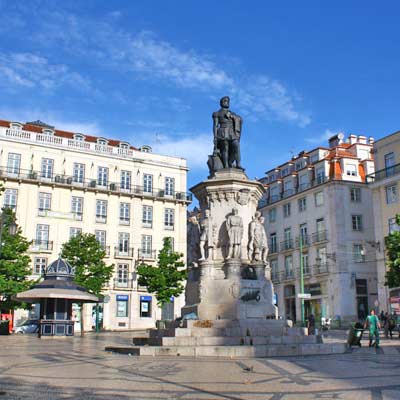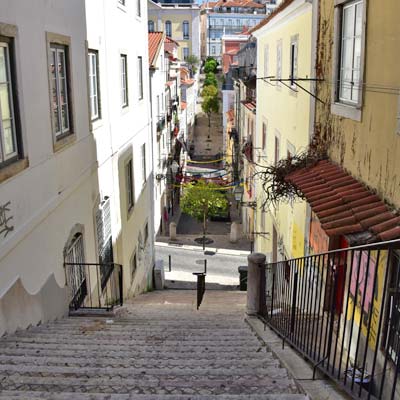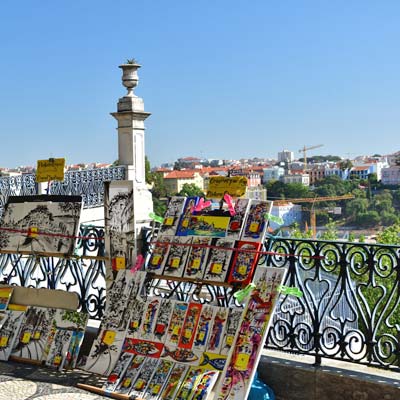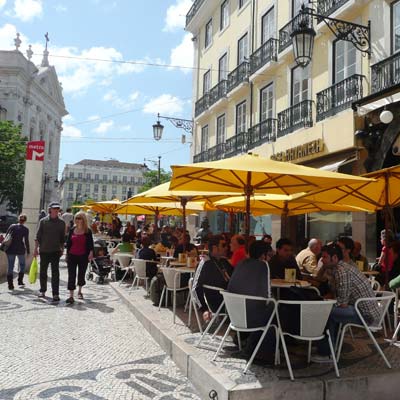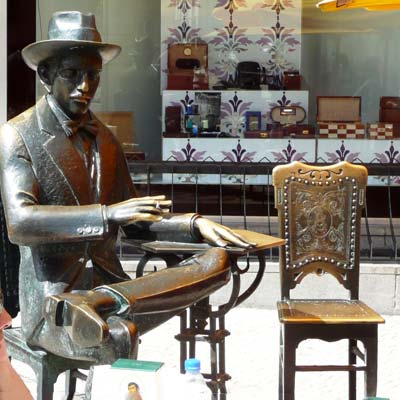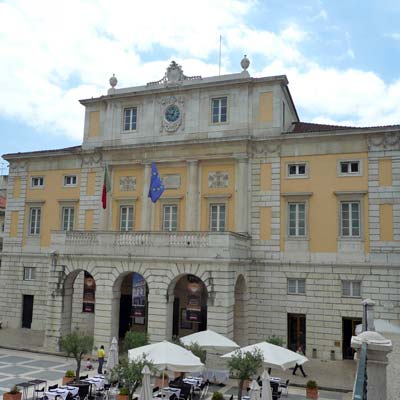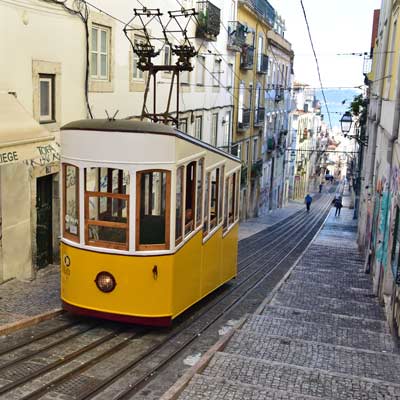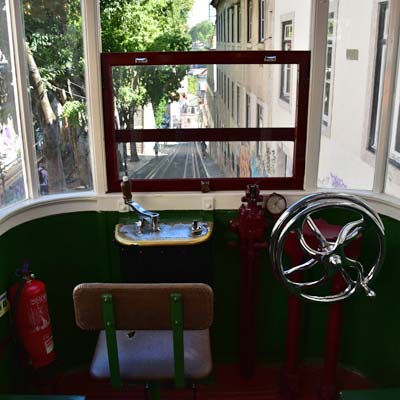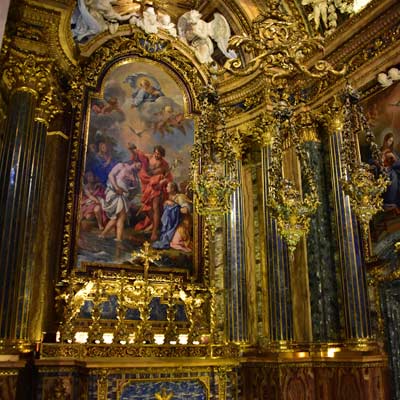LisbonLisboaPortugal.com
The best independent guide to Lisbon
LisbonLisboaPortugal.com
The best independent guide to Lisbon
Bairro Alto and Chiado districts of Lisbon
No two districts better represent the dual character of Lisbon than Chiado and Bairro Alto. Situated side-by-side, they form the city's cultural and social epicentre, offering a seamless transition from sophisticated daytime pursuits to energetic nightlife.
By day, the focus is on Chiado, a district of elegant squares, historic theatres, and grand 19th-century buildings. This is Lisbon's traditional shopping area, where international brands on Rua Garrett mix with historic institutions like the Livraria Bertrand bookshop. It's also a cultural hub, home to the iconic Café A Brasileira and the striking ruins of the Carmo Convent.
As evening arrives, the energy shifts uphill to the narrow, grid-like streets of Bairro Alto. A neighbourhood that is largely quiet during the day completely transforms as dozens of small bars, Fado houses, and restaurants open their doors. The culture here is famously social, with crowds spilling out from the bars to drink and talk on the cobbled streets, creating one of Europe's most concentrated and lively nightlife hubs.
This guide details the best of both Chiado and Bairro Alto, from historic landmarks and unique shops to the best restaurants and most authentic bars. It explains how to navigate these two essential districts and experience the full spectrum of Lisbon's social life.
Highlights of Chiado and Bairro Alto
A suggested tour of Chiado and Bairro Alto
Bairro Alto and Chiado have a lot for you to see, and four hours can easily be spent exploring the two districts. The districts are frequently visited after the Baixa district, and this tour begins at the Rua Garrett, the main street between Baixa and Praça Luís de Camões. This is also close to the Baixa-Chiado metro station.
Major sights along the route are: 1) Rua Garrett 2) Elevador de Santa Justa 3) Convento do Carmo 4) Igreja de São Roque 5) Jardim de São Pedro de Alcântara 6) Pavilhão Chinês 7) (shaded area) Nightlife centre of Bairro Alto 8) Praça Luís de Camões 9) Elevador da Bica 10) Miradouro de Santa Catarina
This route covers 4.2km and takes 4 hours. All the steep hills are climbed at the beginning, between the Rua Garrett (1) and the Igreja de São Roque (4), and afterwards it is all downhill or flat.
The tour could be extended into the Príncipe Real district after visiting the Pavilhão Chinês (6) or Cais do Sodré after seeing the Elevador da Bica (9).
Related articles: Príncipe Real district - Cais do Sodré district
Introduction to Bairro Alto
Found within a relatively compact area, are over two hundred family-run restaurants and small bars, catering for every genre and taste. Many of these bars are tiny, only providing seating for a handful of patrons, so as the night progresses the socialising spills out on the streets, and the entire district is one huge party.
As Bairro Alto is nightlife focused, a visit of the central streets during the day may leave you a little underwhelmed. The graffiti and ramshackle streets are not much to see, and many of the main tourist attractions (Igreja São Roque, Carmo Church, Praça Luís de Camões) are along the eastern and southern sides. Return after sunset and there is no more fun place in Lisbon than Bairro Alto.
Insight: The grid/block layout of central Bairro Alto is unique for a city district that dates from the medieval era, but this original layout followed ancient farming plots which were rectangle in size.
Introduction to Chiado
Chiado is a much smaller district than Bairro Alto and was historically the high-class shopping area of Lisbon.
During the 19th century the district became the popular with of artisans and intellectuals, who would frequent the coffee shops and bars.
Insight: The district is named after, António Ribeiro, a Franciscan monk who left the order to become a satirical poet and actor. António’s distinctive style was his shrill and high voice, which gave him the nickname Screech (Chiado in Portuguese).
Insight: The statue of Fernando Pessoa depicts him drinking coffee outside the Café A Brasileira, but in fact he rarely visited here, much preferring the Martinho da Arcada café in the Praça do Comércio.
Archive footage of the Chiado fire: https://sicnoticias.pt/
How about a small group tour?
One of the best ways to discover Lisbon and to meet fellow travellers is to join a guided tour. We have worked with Getyourguide.com for the last six years, and some of the best tours of Lisbon include:
The Funiculars
Navigating the steep hill of Chiado and Bairro Alto has always been a struggle for residents who lived here. The industrial revolution brought novel ideas and ingenious modes of transport and included the construction of two funiculars (Gloria and Bica) and a lift (Elevador de Santa Justa). All three are part of the public transport network but are primarily aimed for tourists.
The Elevador de Santa Justa connects the Rua Augusta (Baixa) to the Largo do Carmo (Bairro Alto) and is an industrial age lift, that was originally powered by steam. The top deck, where the steam engine once was, is now a panoramic viewpoint. The Elevador de Santa Justa is an enjoyable experience, but there can be very long queues in the summer to travel up.
Tourists advice: The fares for the funicular and lift are comparatively expensive; Gloria and Bica €4.20 and Santa Justa €5.30. A much cheaper method is to purchase a 24hour unlimited public transport ticket (€7.00) from any metro station. This ticket includes the funiculars, the Santa Justa and the historic 28 tram (along with all buses, metro and trams), and is exceptionally good value.
Related articles: Elevador de Santa Justa – Number 28 tram
The Igreja de São Roque
The unassuming exterior of the Igreja de São Roque provides no indication of the exquisite interior. The church contains some of the finest examples of Portuguese Baroque religious art and designs, with its decorative altars and beautiful painted Trompe-l'œil ceiling.
The Igreja de São Roque was constructed by the Jesuits as an “auditorium styled church” designed for preaching. After the Jesuits were expelled from Portugal in 1759, the church and buildings were donated to the Santa Casa da Misericórdia de Lisboa, an early styled charity to help the poor.
The Capela de São João Baptista is regarded as the most expensive altar ever constructed, not only is it decorated with semi-precious stones, gold leaf and fine art, it was constructed twice. Once for the Pope to bless in Rome, then it was dismantled and transported to Lisbon where it was rebuilt in the Igreja de São Roque.
Igreja do Carmo Church
The Igreja do Carmo is the chilling memorial to the devastating earthquake that struck Lisbon on 1st November 1755. Hundreds were killed as the roof collapsed on the congregation gathered for the feast of All Saints, and the fires ignited from the toppled candles raged for days.
Contained within the skeleton remains of the vaults and arches is an archaeological museum (€5.00): https://www.museuarqueologicodocarmo.pt/
The former convent attached to this once mighty church has been repurposed as the GNR police headquarters. This complex is historically important as it was here that Estado Novo surrendered power after 50 years of dictatorship during the 1974 Carnation Revolution.
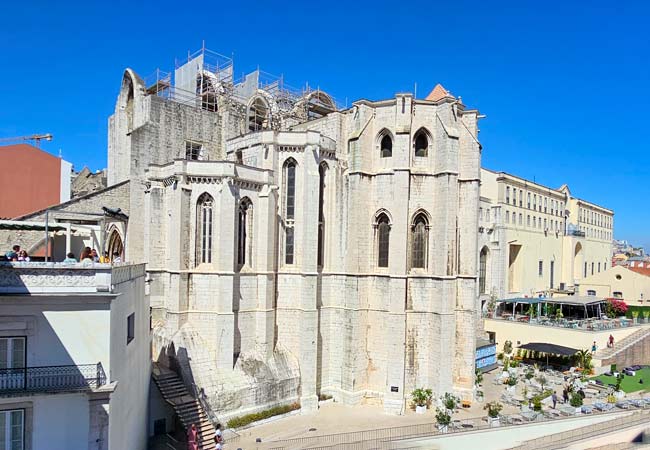
The ruins of Carmo Church
The Jardim de São Pedro de Alcântara viewpoint
The Jardim de São Pedro de Alcântara viewpoint provides wonderful views across central Baixa and over to Lisbon castle. The view point is at the end of the Elevador da Gloria funicular route just to the east of Bairro Alto .
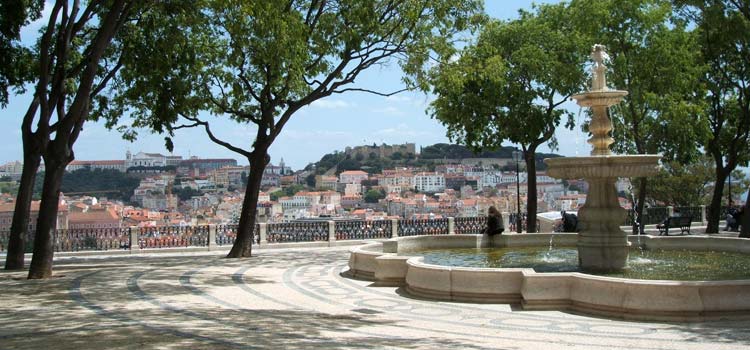
The Jardim de São Pedro de Alcântara viewpoint
Cafe a Brasileira
The “Cafe a Brasileira” is one of Lisbon’s most iconic cafes, it was here during the 19th century Portugal’s academics and intellectuals could discuss the pressing issues of the day, while struggling artists would sell their paintings. Outside the Cafe a Brasileira is a statue of Fernando Pessoa, who ironically disliked the Cafe A Brasileira but preferred to spend his time in a café near to Praça do Comércio. To read more please click here.
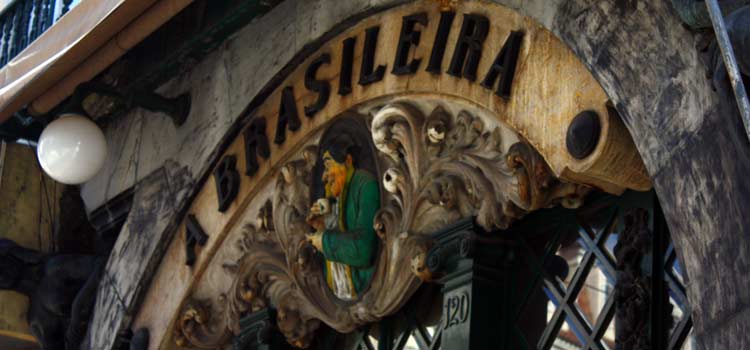
The cafe Brasileira is a popular place for a drink
Does Bairro Alto have the best Nightlife in Lisbon?
Simply put, yes.
Bairro Alto is the nightlife hub of Lisbon with countless small bars, trend intimate venues and restaurants where the haunting sounds of Fado can be heard waft out. During the weekends the revellers spill onto the streets and there is carnival atmosphere along the narrow cobbled streets, filled with people enjoying the night. Nights in Bairro Alto do not discriminate with everyone having a fun time and there is always a happy mix of foreigners, locals, gay, straight, young and old.
A night typical begins at the centre of Bairro Alto, (between Rua do Norte and Rua da Atalaia), as the night progresses, people tend to congregate along the Rua da Bica de Duarte Belo and Praça Luís de Camões before heading to the late-night clubs of Cais do Sodré and Pink Street. The bars in Bairro Alto have a closing time of 2am whereas Pink street stays open till the sun rises.
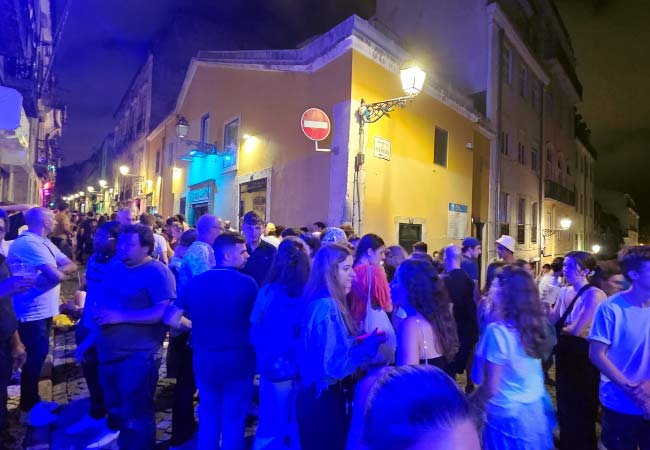
The small bars of Bairro Alto spill out onto the streets
Bairro Alto is the place to head to for a fun Lisbon night but is not the area to be based in for quiet nights, as the partying continues late into the night most days during the summer. The appearance of Bairro Alto also reflects that of its numerous partying patrons; fun-loving and loud at night but distinctly worse for wear during the day. Bairro Alto does not look great during the day, the district is sadly blighted with graffiti, and the streets do look shabby when exposed to the bright sunlight of Lisbon.
Discover more of Lisbon with our most popular guides
If you've found our content valuable, we'd welcome your support.
The digital publishing landscape has evolved significantly. As a small independent publisher, we face growing challenges. Search engines increasingly favour paid content over organic results, while AI-generated content often reproduces original work without attribution.
To support our work, please consider bookmarking this page (press Ctrl + D) for quick access. If you find an article helpful, we'd be grateful if you'd share it with friends on social media.
For specific questions, please see our Reddit community at r/LisbonPortugalTravel.
Should you notice any outdated or incorrect information, please contact us at [email protected]
Thank you for helping us continue to provide valuable content in an increasingly challenging digital environment.
A complete list of all of our Lisbon articles
If you've found our content valuable, we'd welcome your support.
The digital publishing landscape has evolved significantly. As a small independent publisher, we face growing challenges. Search engines increasingly favour paid content over organic results, while AI-generated content often reproduces original work without attribution.
To support our work, please consider bookmarking this page (press Ctrl + D) for quick access. If you find an article helpful, we'd be grateful if you'd share it with friends on social media.
For specific questions, please see our Reddit community at r/LisbonPortugalTravel.
Should you notice any outdated or incorrect information, please contact us at [email protected]
Thank you for helping us continue to provide valuable content in an increasingly challenging digital environment.
